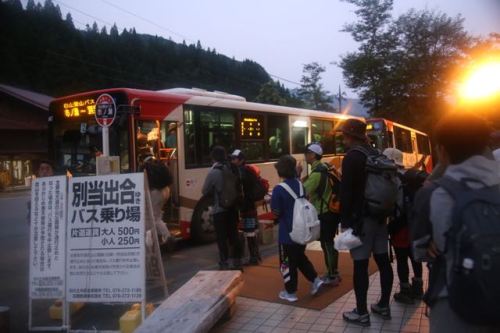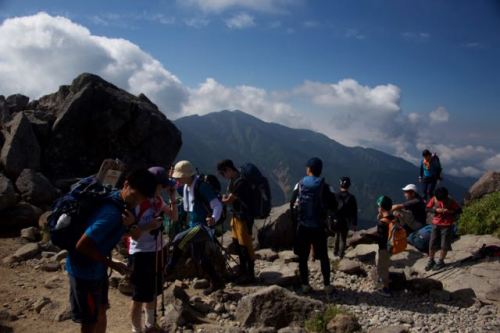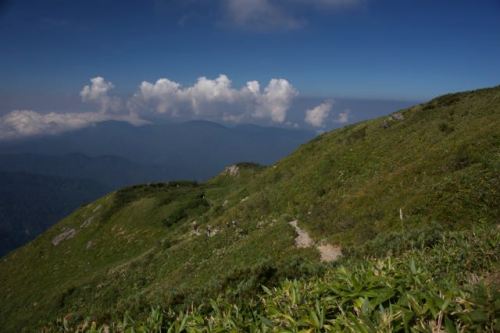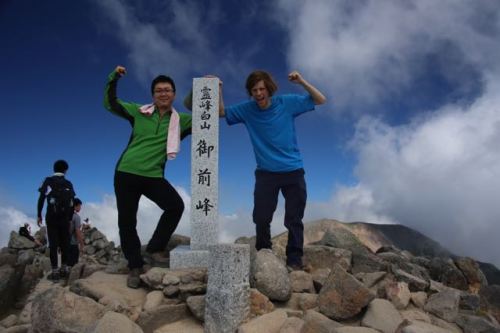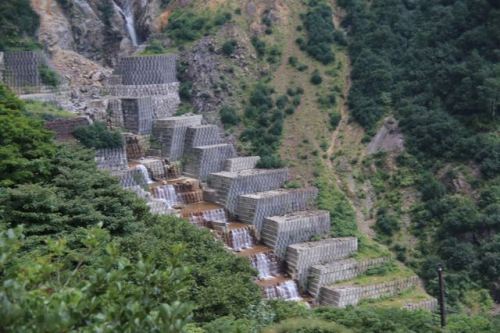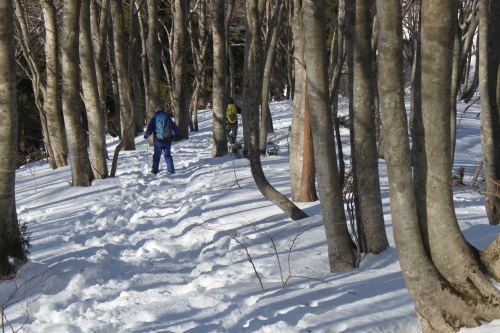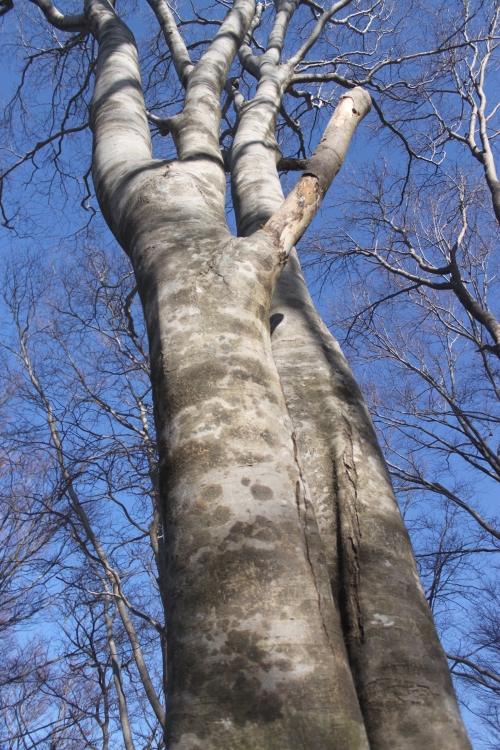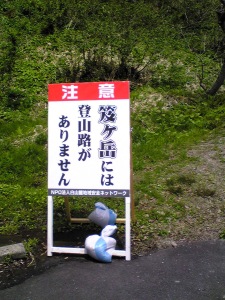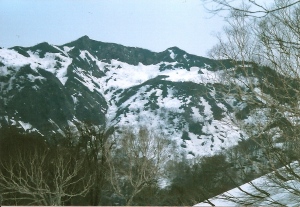I thought my snowshoe hiking was done for the season. With temperatures already exceeding 20 degrees and the snow in the Kansai region but just a distant memory, I resign myself to a few easy hikes while waiting for the pollen to subside. In comes a text from my friends Hisao and Haru in Nagoya with an invite to climb Mt. Nōgohakusan in southern Gifu Prefecture, but the approach becomes daunting due to construction work on the forest road leading to the trailhead. To make matters worse, Haru drops out due to family commitments, so Hisao and I brainstorm ideas for a new target. I casually mention that I have never climbed Mt Dainichi-ga-take in northern Gifu and he enthusiastically jumps into action.

Right on cue, a cold pressure system moves in over the Sea of Japan, depositing fresh powder on our peak in the days leading up to our scheduled ascent. I board a nearly deserted Shinkansen train to Nagoya, ground zero for the coronavirus infection slowly gaining ground here in Japan. Donning a mask and cautious of what I touch, I make it to Hisao’s local station and we head off to a discount shop to purchase food for the hike. We hit the hay early, as the alarm is set for 4:45am. We are on the road by 5am under clear skies tinted yellow by the pollen and aeolian dust wafting through the air. Dense fog takes over after that, guiding us over a mountain pass and down into a broad valley in northern Gujō city where we break out of the clouds and are greeted with a sight to behold – the towering white face of Dainichi staring us straight in the eye.

Hisao guides his Honda to the trailhead shortly before 7am under a cloudless sky. Half a dozen other cars sit in the narrow snow-covered parking lot as we sort through gear in eager anticipation of our climb. We’ve chosen the summer route, a path that Hisao has climbed once before. When heading to the mountains in winter, it is best to go to a place that at least one member of your party is familiar with. He assures me that it’s a straightforward route, but as we stare up at the summit plateau, the distance looks formidable. Can we really make it up there in just 3 hours?

The snow is patchy at the start, but I tempt fate by strapping on my snowshoes in the parking lot, surmising that it will be easier here where the snow is just centimeters deep. A narrow gully awaits us as we place our first footfalls into the soft snow. Hisao has opted to keep his wakan strapped to his pack, a wise decision as we soon reach a steep climb dominated by tree roots sticking out from under a thin covering of snow. It is tricky work in snowshoes, but I maintain a careful placement of footsteps until the snow becomes deeper with each successive gain in elevation. A few steep sections later and we pop out on the main ridge glistening with fresh powder snow – not something we expect to find on the second day of spring.

There is a clear trace to follow, but such footsteps were not designed with snowshoes in mind, so I spend most of the time forging my own path directly adjacent to the footprints. I sink down a foot or so with each step, as the wet snow buries my boots, making each advancing step feel as if I’m carrying a barbell strapped to both feet. Hisao is amused by my struggles, for he makes good progress by following precisely the footprints made by the climbing parties ahead of us, but I keep the snowshoes strapped to my feet, for carrying them on my rucksack would just add extra weight to my upper body.

Luckily the snow condition improves as we reach Ippuku-daira, a level plateau located at around 1300 meters of elevation which marks the halfway point in our ascent. We pause briefly, shedding layers as I refill my water bottle and stuff morsels of food into my dry mouth. Hisao is completely covered in sweat, and our idyllic break spot would be perfect if not for the cacophony of blaring loudspeaker J-Pop piercing through the air from Takasu Snow Park across the valley. We’ve purposely chosen this route to avoid the ski resort, but we can’t escape its grasp entirely.

Into the lead my trusty guide Hisao walks, flowing seamlessly through the deep snow while I continue to struggle. My hard work is paying off, however, as the impressive figure of Hakusan floats high above to my right, completely caked in wintry white. It’s hard to keep my eyes off of her, entralled as I am by her sheer beauty. Hisao maintains his breakneck pace, keeping about a quarter of a kilometer ahead of me on the rambling ridge line. The snow condition finally improve at 1500 meters in elevation, turning into dry crystalline powder, the trail being sandwiched between a large cornice on my left and a windswept ice crust to my right. I make amazing progress on the icy crust as my snowshoes glide smoothly over the surface while Hisao postholes with each advancing step. The howling wind has covered up the trace of the hikers in front of us and I soon overtake my partner for the final climb to the summit. I look behind me and watch Hisao struggle up the last few meters of deep powder while I push on with ease.

As we crest the summit plateau, the full force of the winds pushing in from the nearby sea hit us head on, nearly knocking us off our feet. A handful of backcountry skiers brace themselves against the gale, which fortunately soon subsides. The skiers have come from the neighboring ski resort in search of untracked powder, but I am glad we chose the long way up. It feels much more rewarding to climb a mountain from its base than the cheat by taking the gondola most of the way up.

Hisao and I take in the views and sunshine while eating our well-deserved snack of ichigo daifuku, a savory strawberry smothered with bean paste and wrapped in a soft blanket of rice cake. Hisao swears that wagashi make the best hiking treats, and over the years I’ve seen him eating not only mochi and dango, but bars of calorie-packed yōkan as well. Perhaps there is something to his fueling approach after all. I usually just go for a Calorie Mate and a rice ball and some chocolate, but I’m willing to take a more traditional approach for my next mountain meal.

With the winds picking up and temperatures starting to drop, we run off the summit plateau, kicking balls of snow far ahead of us while blazing our own path down the main ridge that we had climbed earlier. Hisao, now donning his wakan, keeps pace in the steeper sections, but as the path flattens out he needs to stick to the main trail as he sinks too deeply in the deep powder. I make my own path through untracked sections of snow and we return to Ippuku-daira in just half the time it took us to ascend. We shed layers and rehydrate before continuing on our march back to the car. We play an entertaining game of who can last the longest before taking off their climbing equipment, and once we drop off the ridge down the spur the snow cover becomes sparse and the mud takes over. We call it a draw and sit on a toppled tree trunk to take off the snowshoes, which by now have accumulated quite a thick layer of wet snow. I strap them on the outside of my rucksack as we walk the remaining snow-free distance back to the car, arriving shortly after noon.

Such epic climbs can only be topped by a soak in a local hot spring, so Hisao finds a beauty of a place on his car navigation system while we settle in for a refreshing bath and filling tonkatsu lunch. The dining room overlooks a narrow valley and we both wonder if this place will survive the impending viral and economic storm about to be unleashed in Japan.

















